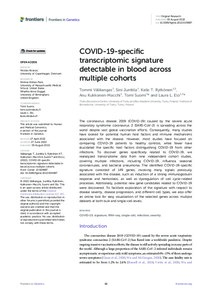COVID-19-specific transcriptomic signature detectable in blood across multiple cohorts
Kukkonen-Macchi Anu; Välikangas Tommi; Rytkönen Kalle T; Elo Laura L; Junttila Sini; Suomi Tomi
COVID-19-specific transcriptomic signature detectable in blood across multiple cohorts
Kukkonen-Macchi Anu
Välikangas Tommi
Rytkönen Kalle T
Elo Laura L
Junttila Sini
Suomi Tomi
FRONTIERS MEDIA SA
Julkaisun pysyvä osoite on:
https://urn.fi/URN:NBN:fi-fe2022091258431
https://urn.fi/URN:NBN:fi-fe2022091258431
Tiivistelmä
The coronavirus disease 2019 (COVID-19) caused by the severe acute respiratory syndrome coronavirus 2 (SARS-CoV-2) is spreading across the world despite vast global vaccination efforts. Consequently, many studies have looked for potential human host factors and immune mechanisms associated with the disease. However, most studies have focused on comparing COVID-19 patients to healthy controls, while fewer have elucidated the specific host factors distinguishing COVID-19 from other infections. To discover genes specifically related to COVID-19, we reanalyzed transcriptome data from nine independent cohort studies, covering multiple infections, including COVID-19, influenza, seasonal coronaviruses, and bacterial pneumonia. The identified COVID-19-specific signature consisted of 149 genes, involving many signals previously associated with the disease, such as induction of a strong immunoglobulin response and hemostasis, as well as dysregulation of cell cycle-related processes. Additionally, potential new gene candidates related to COVID-19 were discovered. To facilitate exploration of the signature with respect to disease severity, disease progression, and different cell types, we also offer an online tool for easy visualization of the selected genes across multiple datasets at both bulk and single-cell levels.
Kokoelmat
- Rinnakkaistallenteet [19207]
